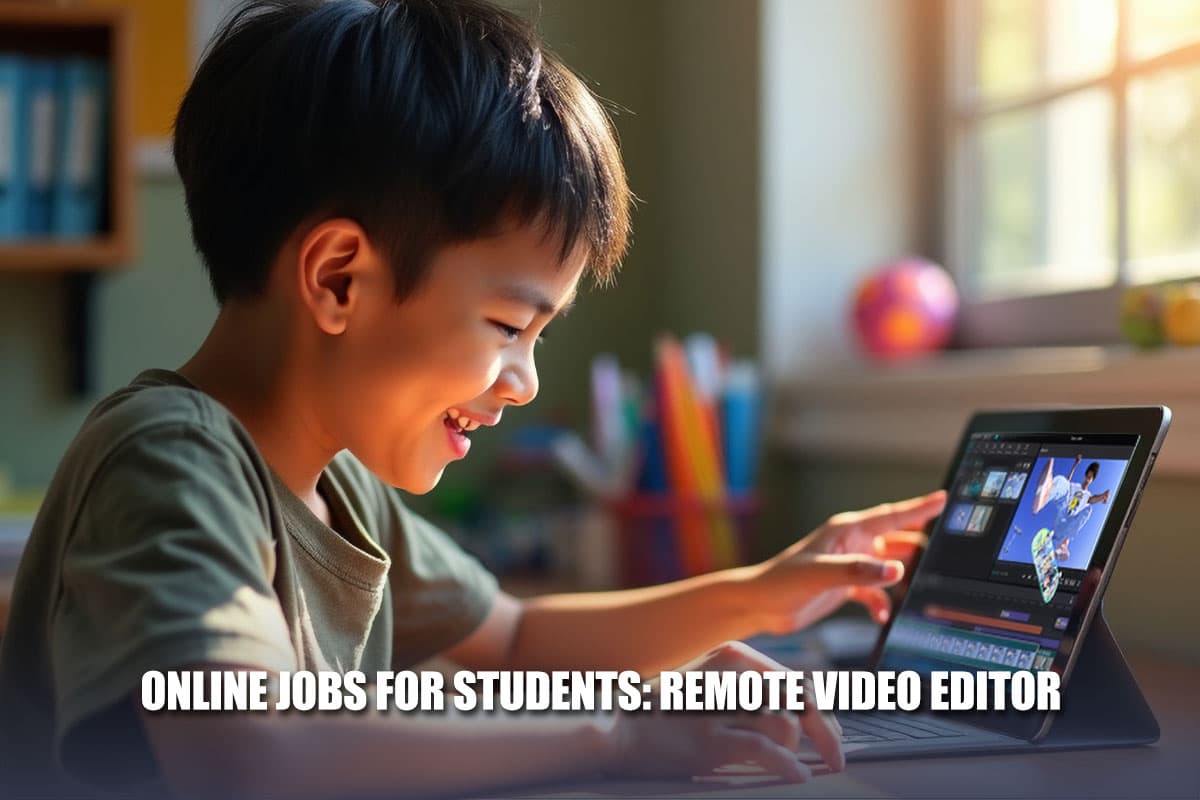The gig economy is thriving, especially in freelance and remote work like video editing. The Philippines has become an attractive outsourcing location due to its skilled workforce.
Remote video editing is a flexible and in-demand career path. It's more than just cutting and splicing footage; it requires a keen eye for detail, a creative mind, and proficiency in video editing software.
Aspiring video editors must be self-starters with strong organizational problem-solving skills. The demand for remote video editors is rising, with television companies, post-production studios, and influencers seeking talented individuals to create compelling visual content.
Here's what you should know if you are a student looking for an online job as a remote video editor. This guide can help you prepare to earn extra income, essential work experience, and relevant skills.
How to Become a Remote Video Editor

Starting your career as a remote video editor offers a blend of creativity and technical skills. The profession transforms raw film footage into polished, cohesive stories for diverse platforms and purposes. This includes movies, TV shows, promotional videos, and social media content.
1. Learn the necessary skills
While formal education is optional for remote video editing, many professionals hold a bachelor's degree in video production, film production, or multimedia arts.
These programs make aspiring remote video editors more competitive with hands-on experience with commonly used software.
For instance, remote video editors select the best shots. Then, they blend them with graphics, music, and other elements to ensure the video conveys its message effectively.
- Technical Skills: Proficiency in video editing software such as Adobe Premiere Pro, Final Cut Pro, DaVinci Resolve, and After Effects is essential. Remote video editors should also understand different video formats and codecs. Knowledge of color correction and grading is crucial for ensuring visual consistency and setting the video's tone.
- Interpersonal Skills: Editing isn't just a solo gig. You need an eye for detail, superb organizational skills, and the ability to solve problems quickly. Plus, you'll chat with clients and collaborate with teams, so good communication is key.
Some online resources that can help you learn video editing skills include the following:
- Noble Desktop offers free training seminars, video tutorials, and in-person and live online video editing courses. They also provide free trial versions of video editing software like Final Cut Pro and Adobe Premiere Pro.
- YouTube Tutorials are another great resource. Many content creators share their knowledge of video editing, offering tutorials on various techniques and software.
- Udemy provides video editing courses taught by professionals, covering everything from basic editing to advanced techniques.
- Skillshare offers classes on video editing where you can learn about different tools and techniques.
- LinkedIn Learning, known for its professional courses, provides video editing tutorials that can help improve your skills.
2. Gain Proficiency in Editing Software
Mastering a range of software, from basic ones like iMovie or Adobe Premiere Rush to more advanced ones, makes you a more attractive candidate for many projects.
Video editing is constantly changing, with new software and updates coming out. Learning new tools fast is key to staying current and competitive. Here's a guide for these editing platforms to help you keep up.
Avid Media Composer
- Begin with Avid's Official Training: Avid offers various training levels, from beginner to advanced. Their official website provides resources, tutorials, and certification programs to help you master Media Composer.
- Regular Practice is Key: Hands-on experience is crucial. Start with small projects to get comfortable with the interface, then gradually tackle more complex edits.
- Engage with Avid Communities: Join forums and social media groups for Avid users. Engaging with other editors can provide valuable insights and tips from experienced users.
DaVinci Resolve
- Start with Blackmagic Design Training: Begin with the free training provided by Blackmagic Design on their website. They offer comprehensive guides on editing, color correction, visual effects, and audio post-production.
- YouTube Tutorials: Dive into the wealth of knowledge available on YouTube. Channels dedicated to DaVinci Resolve often post tutorials covering basic and advanced techniques.
- Practice with Projects: Apply what you learn by working on real projects. Whether it's personal videos or volunteer projects, practicing will help you experiment with different aspects of DaVinci Resolve.
Final Cut Pro
- Explore Apple's Training Resources: Apple offers a variety of resources for learning Final Cut Pro. These cover basic editing to advanced features like 360-degree video and color correction.
- Take Online Courses: Udemy and Skillshare offer a range of Final Cut Pro courses for beginners and advanced users.
Adobe Premiere Pro
- Earn Adobe's Official Certification: Consider becoming an Adobe Certified Professional in Premiere Pro. This certification validates your skills and makes you more appealing to potential employers.
- Explore Tutorials and Online Courses: A wealth of tutorials online cover every aspect of Premiere Pro. Start with Adobe's tutorials, then explore YouTube channels and courses on e-learning platforms for more in-depth learning.
- Engage with the Community: Platforms like Reddit and other forums host active communities of Premiere Pro users. Participating in these communities can provide you with support, feedback, and new ideas.
3. Teach Yourself and Practice
You can teach yourself video editing using online resources such as YouTube tutorials and online classes. Then, break down tasks into smaller, manageable parts and learn how to accomplish each. You can practice editing by familiarizing yourself with keyboard shortcuts for your editing software. This can greatly speed up your editing process, making you more efficient.
Additionally, analyze videos from editors or brands you admire. Try to understand their editing style and techniques, and consider how to add similar elements to your work.
4. Build a portfolio
Students aspiring to become remote video editors should build a solid portfolio that showcases their skills. Without clients, use stock footage to create new videos or enhance existing ones to demonstrate your editing skills.
Identify your target audience and the type of projects you want to work on, such as music videos, short films, or ads for brands. Make sure your portfolio reflects the kind of work you're seeking.
- Use portfolio websites like Carbonmade, Behance, or your own website to showcase your work. Ensure your portfolio is user-friendly and accessible to potential employers.
- Create a demo reel around 60 to 90 seconds short to showcase your best work and unique abilities.
- Share your edited work on social media platforms like TikTok or Instagram, where potential employers might discover your talents.
5. Search for Freelance Gigs
You can explore several popular job websites online when finding remote video editing jobs. However, competition can be stiff, so you must build a strong profile. Engage with the video editing community online through forums, social media platforms, and professional networks.
Networking can lead to freelance opportunities and valuable industry connections. Finally, contact companies or content creators you admire and inquire about remote video editing opportunities. This can sometimes lead to exciting collaborations.
Job Responsibilities of a Remote Video Editor

- Collecting raw video and transferring it to a computer
- Following a script or outline
- Adding sounds, like music or voice-overs
- Adding graphics
- Editing videos digitally to create a rough cut
- Adjusting lighting, coloring, and fixing any issues
- Collaborating with directors to match their vision
- Editing films so the cuts are seamless and invisible to the audience
- Understanding the needs of the production team
- Reviewing scripts and raw footage to plan the editing process
- Trimming and arranging footage
- Adding music, dialogue, graphics, and sound effects
- Creating rough and final edits
- Ensuring the video flows logically
- Communicating with stakeholders throughout the editing process
Challenges of Working as a Remote Video Editor

Editing videos remotely can be challenging. It affects your pacing and how well you work with others. However, there’s a solution for every challenge. Let's look at some common problems remote video editors face and how to solve them.
Real-Time Collaboration
Real-time collaboration helps align the final product with the vision of directors, producers, and other team members. Remote work, however, can introduce significant challenges. This includes lag during screen-sharing sessions, which hampers effective collaboration.
Solution: Platforms specifically designed for video production teams like Evercast can significantly improve real-time collaboration.
These platforms prioritize low-latency streaming, allowing team members to watch edits in real time. They can also make timestamp-specific notes and communicate effectively, all within a single platform.
Moving Large Media Files
Remote video editors often need help moving large media files, which can be a big and slow process. As video quality gets better, the files get bigger.
For example, one minute of uncompressed 1080p video at 60 frames per second can be about 10.5 gigabytes (GB).
For 4K video at the same frame rate, it can be about 42 GB per minute. These sizes get even bigger with higher frame rates and bit depths. This makes transferring raw footage, middle steps, or even finished edits hard, especially when working remotely with others.
Solution: Consider using fast cloud solutions to speed up transferring big files. These services don't need extra setup and offer a reliable way to move large files with little data loss.
For example, Dropbox lets you share files up to 100 GB or more. It's secure and accessible, making collaboration easier without physical storage devices.
File Security
When remote video editors handle projects with private information, there's a higher risk of unauthorized access to sensitive content. This risk is greater because video editing involves transferring and storing large files that might contain confidential material.
Sharing files between team members who use different operating systems can create security weaknesses if not handled carefully, potentially allowing unauthorized access.
Solution: For projects with sensitive information, using services with strong encryption, like LucidLink, is crucial. This ensures that only authorized team members can access the files.
Watermarking and encryption secure files in a remote video editing setup. This helps stop theft and unauthorized sharing. Choose a reliable encryption tool like AxCrypt, which supports strong standards like AES-256 and works on many platforms for easy use.
Best Video Editors for Beginners
For starters, finding video editing tools that are both easy to use and powerful can be tricky. Luckily, several options exist with intuitive interfaces and plenty of editing features to enhance your projects. Here are three top picks for beginner-friendly video editing software:
1. iMovie
iMovie is free and easy to use, especially for beginners, with a simple interface. It's already installed on Macs, so it's ready to use.
It has basic editing tools like trimming and adding effects. Best features include Magic Movie for automatic editing, storyboard templates, and picture-in-picture effects. You can also share directly on social media.
2. DaVinci Resolve
DaVinci Resolve is a free video editor with a paid version (DaVinci Resolve Studio) offering extra features. It's more advanced than iMovie but has plenty of tutorials and a helpful community.
DaVinci Resolve is great in color correction, visual effects, audio post-production, and editing. DaVinci Resolve supports collaboration and works on both Windows and Mac.
Users prefer it for its tools like chroma keying, object tracking, stabilization, and lens correction. Beginners and professionals can cut pages for quick edits and a traditional layout for complex projects.
3. Wondershare Filmora
Wondershare Filmora offers a free version with basic features and paid plans for more options. The lifetime license includes AI features; check their website for pricing. It's beginner-friendly, with templates and a social media focus, and has many effects and transitions.
4. CapCut
CapCut is a free video editing app designed for mobile devices and tablets. It is one of the most popular video editing apps among beginners, offering a user-friendly interface and a wide range of features.
CapCut is a mobile video editing app developed by ByteDance, the same company behind TikTok. The app allows users to edit videos on the go, making it an ideal choice for students who want to create professional-looking videos without needing a computer.
Key Features of CapCut
- User-friendly interface: CapCut's intuitive interface makes it easy for beginners to navigate and use, even for those with no prior video editing experience.
- Multi-track editing: The app allows users to add multiple video and audio tracks, enabling more complex and creative edits.
- Advanced editing tools: CapCut offers a range of advanced editing tools, including trim, split, and merge, as well as color adjustment and chroma keying.
- Huge music library: The app has a vast music library, allowing users to add background music to their videos without worrying about copyright issues.
- Effects and transitions: CapCut offers a wide range of effects and transitions, including text, stickers, and color filters, to enhance the visual appeal of videos.
- Export options: The app allows users to export their edited videos in various formats, including MP4, AVI, and GIF.
- Cross-platform compatibility: CapCut is available for both iOS and Android devices, making it accessible to a wide range of users.
Frequently Asked Questions
How much does a video editor get paid remotely in the Philippines?
The average salary for a remote video editor in the Philippines is around ₱25,850 per month. For instance, a senior video editor can earn an average of ₱444,000 per year, about ₱37,000 per month.
This varies based on experience. Early-career senior video editors earn around ₱353,749 per year, and mid-career professionals earn ₱444,000 annually.
How do I get an online job as a video editor?
To land an online video editing job, build an impressive portfolio showcasing your best work. Employers often look at this first. Networking is key, too; join industry forums, attend webinars, and engage on social media where companies share job openings.
Tailor your applications with a personalized cover letter and resume for each job.
Also, be ready to discuss your skills and experience in interviews. Stay flexible for tight deadlines and always communicate professionally with potential employers.
Is video editing good for freelancing?
Freelancing in video editing is a great option. You can choose when and where you work, often just needing an internet connection. You're in control of the projects, you can work from home and set your rates and schedule.
Plus, there's a high demand for video content in many industries, so there's plenty of work available.
However, freelancers must be good at marketing, building their brand, and managing client relationships. Sometimes, work might need to be more consistent, and you won't have benefits like health insurance.
Still, freelancing is among the best online jobs for students, especially motivated ones.
How do you create a video portfolio?
Building a video portfolio as a student without experience is about showing off your creativity and technical skills. Start by working on personal projects or sample assignments demonstrating your editing skills.
These projects can be based on your interests or real-world briefs to show your skills. Join group projects, hackathons, or online challenges to gain collaborative experience and add variety to your portfolio.
You can also create videos for school assignments or volunteer to make content for local organizations. Host your portfolio on platforms like YouTube, Vimeo, or your own website to make it easy for people to see your work. Share your process through blog posts or behind-the-scenes videos highlighting your problem-solving skills and creativity.
What is a good free online video editor?
Canva's free online video editor is incredibly user-friendly, offering a drag-and-drop interface. It includes various clips, audio tracks, and animations, with real-time collaboration.
Another option is VEED. It has AI-powered features like auto-subtitles and voice translations. Plus, it can record voiceovers directly in the editor.
Conclusion
Remote video editing offers a mix of job satisfaction, earning potential, work-life balance, and skill development. It's attractive to students seeking a part-time job or those considering a full-time career.
Film and video editors report high career happiness, with opportunities for good income and flexibility. Plus, the field's continuous growth in demand makes the skills developed in this role valuable and sought after.
If you have a passion for editing videos and are looking for a flexible online job that can fit around your studies. Becoming a remote video editor could be the perfect opportunity for you.
However, if video editing is not your only interest or skill, we have a range of other online job articles that may be worth exploring. Including virtual assistant, customer service, graphic design, online tutor, web designer, freelance writer, and social media manager.
Whatever your skills or interests, there is likely an online job that suits you. With the flexibility to work from anywhere, you can easily balance your work and studies.





May I asked, what if the company is dou...